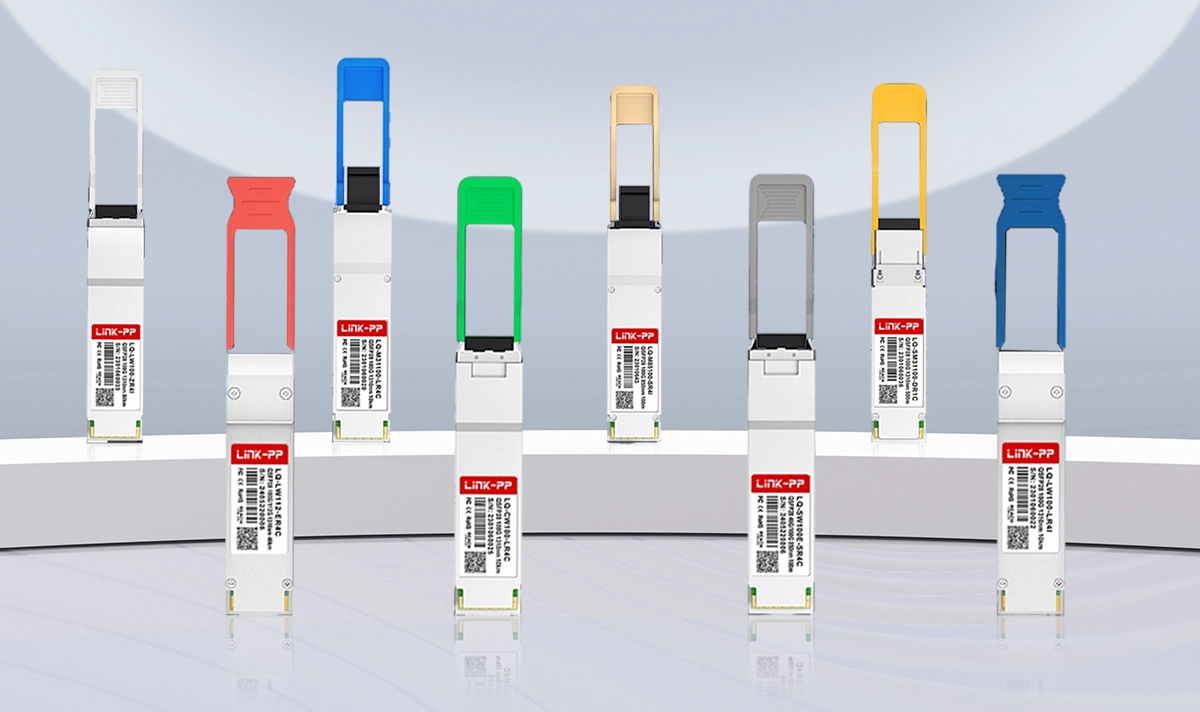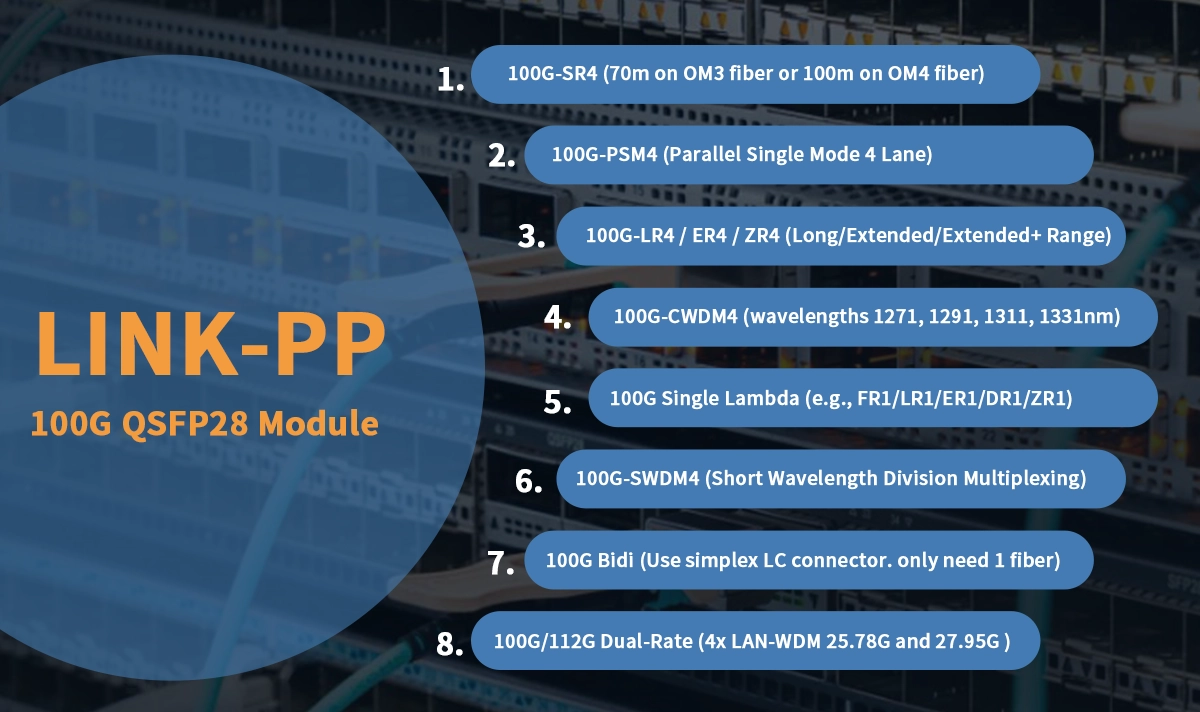
When you pick a 100G QSFP28 transceiver, think about what your network needs. Check important things like compatibility, how far data must travel, fiber type, connector type, where you will use it, and if it will work in the future. Choosing QSFP28 optical transceivers that fit your system helps your network work well and keeps your money safe. This definitive guide cuts through the confusion, exploring all major 100G QSFP28 options – from SR4 and LR4 to CWDM4, Single Lambda, and beyond – helping you make an informed decision for your high-speed connectivity needs.
📝 What is a QSFP28 Optical Module?
The QSFP28 (Quad Small Form-factor Pluggable 28) is the industry-standard form factor for 100 Gigabit Ethernet (100GbE) and high-speed data center interconnects. It packs four lanes operating at 25Gbps or a single high-speed lane into a compact, hot-pluggable module.
📝 Demystifying Your 100G QSFP28 Options: A Technical Breakdown
100G-SR4 (Short Range)
Technology: Parallel multimode fiber (MMF) using 4 lanes (4x25G NRZ).
Reach: Up to 70m (OM3 MMF), 100m (OM4 MMF), or 150m (OM5 MMF).
Fiber Type: Requires MTP/MPO-12 connector. Uses 4 fibers for Tx and 4 fibers for Rx (8 fibers total).
Best For: Top-of-rack switching, intra-data center links, server-to-leaf connectivity within racks or rows using multimode fiber cabling. Cost-effective for short distances.
Model Example: QSFP28-100G-SR4 LINK-PP LQ-M85100-SR4C (Supports OM3/OM4/OM5)
100G-PSM4 (Parallel Single Mode 4 Lane)
Technology: Parallel single-mode fiber (SMF) using 4 lanes (4x25G NRZ).
Reach: Typically up to 500m over standard SMF.
Fiber Type: Requires MTP/MPO-12 connector. Uses 4 fibers for Tx and 4 fibers for Rx (8 fibers total).
Best For: Longer intra-data center or campus links than SR4 allows, where SMF infrastructure is already deployed or preferred for future-proofing. Less common than CWDM4/LR4 for longer SMF reaches.
100G-LR4 / ER4 / ZR4 (Long/Extended/Extended+ Range)
Technology: Coarse Wavelength Division Multiplexing (CWDM) over duplex SMF. Combines 4 wavelengths (around 1295, 1300, 1304, 1309nm) onto 2 fibers (1 Tx, 1 Rx). LR4 is standard, ER4 offers extended reach, ZR4 offers longest reach.
Reach:
LR4: Up to 10km
ER4: Up to 40km
ZR4: Up to 80km+
Fiber Type: Uses standard duplex LC connectors. Requires only 2 fibers.
Best For: Data center interconnect (DCI), metro networks, building-to-building links, aggregation layers. Essential for long-distance fiber optic transmission. ER4/ZR4 are for specialized, longer-haul applications.
Model Example: LINK-PP QSFP28-100G-LR4 LQ-LW100-LR4C (10km), LINK-PP QSFP28-100G-ER4 LQ-LW100-ER4C (40km), LINK-PP QSFP28-100G-ZR4 LQ-LW100-ZR4C (80km)
100G-CWDM4
Technology: Similar to LR4, uses CWDM over duplex SMF but with slightly different wavelengths (1271, 1291, 1311, 1331nm) optimized for lower cost and power consumption.
Reach: Up to 2km. Defined by the CWDM4 MSA.
Fiber Type: Uses standard duplex LC connectors. Requires only 2 fibers.
Best For: Cost-effective solution for intra-data center SMF links up to 2km (e.g., between buildings on a campus, across larger data halls). A popular alternative to PSM4 for duplex SMF.
Model Example: LINK-PP QSFP-100G-CWDM4 LQ-CW100-FR4C (2km)
100G Single Lambda (e.g., FR1/LR1/ER1/DR1/ZR1)
Technology: Uses a single high-speed wavelength (e.g., 53.125 Gbaud PAM4 modulation) over duplex SMF. Includes various reaches:
FR1 (2km) / LR1 (10km): Common standards.
DR1 (500m): Often uses 1310nm wavelength.
ER1 (40km) / ZR1 (80km+): Longer reach variants.
Reach: Varies (500m, 2km, 10km, 40km, 80km+).
Fiber Type: Uses standard duplex LC connectors. Requires only 2 fibers.
Best For: Next-generation data center architectures, simplifying fiber plant (only 2 fibers needed per link), preparing for 400G/800G (which rely heavily on PAM4). Offers higher port density potential. Key for future-proof network design.
Model Example: LINK-PP QSFP-100G-DR1 LQ-SM31100-DR1C (10km).
100G-SWDM4 (Short Wavelength Division Multiplexing)
Technology: Uses wavelength division multiplexing over MMF. Combines 4 VCSEL-based wavelengths (850, 880, 910, 940nm) onto 2 fibers (1 Tx, 1 Rx).
Reach: Up to 75m (OM3), 100m (OM4), 150m (OM5).
Fiber Type: Uses standard duplex LC connectors. Requires only 2 fibers.
Best For: Leveraging existing LC duplex MMF cabling for 100G, avoiding the need for MTP/MPO upgrades. Ideal for fiber migration strategies where duplex MMF is prevalent.
Model Example: LINK-PP QSFP-100G-SWDM4 LQ-SW100-SR4C (100m)
100G Bidirectional (BiDi)
Technology: Uses a single strand of fiber. Achieves full duplex 100G by transmitting and receiving on two different wavelengths (e.g., Tx 1330nm / Rx 1270nm) over the same fiber.
Reach: Typically up to 10km or 20km over SMF.
Fiber Type: Uses a single simplex LC connector. Requires only 1 fiber strand per link.
Best For: Maximizing existing fiber infrastructure (doubling capacity), fiber exhaust scenarios, cost-effective upgrades where fiber is scarce. Crucial for fiber capacity optimization.
100G/112G Dual-Rate Modules
Technology: Hermetic TOSA with LAN-WDM based DFB 25.78G/s and 27.95G/s data rate support.
Reach: Typically up to 10km over SMF
Fiber Type: Uses standard duplex LC connectors. Requires only 2 fibers.
Best For: 100GBASE-LR4 Ethernet Links, Infiniband QDR and DDR interconnects, Client-side 100G Telecom connections.
Model Example: LINK-PP LQ-LW112-LR4C.

100G QSFP28 Transceiver Comparison at a Glance
Module Type | Technology | Wavelength | Fiber Type & Connector | Max Reach | Key Application |
|---|---|---|---|---|---|
100G-SR4 | 4x25G NRZ (MMF) | 850nm | MMF / MPO-12 | 70m-150m | Short Intra-DC, ToR Switching |
100G-PSM4 | 4x25G NRZ (SMF) | 1310nm | SMF / MPO-12 | 500m | Medium Intra-DC/Campus (Parallel) |
100G-LR4 | 4x25G LWDM | ~1295-1310nm | SMF / LC Duplex | 10km | DCI, Metro, Building Links |
100G-ER4/ZR4 | 4x25G LWDM | ~1295-1310nm | SMF / LC Duplex | 40km / 80km+ | Long-Haul DCI, Metro |
100G-CWDM4 | 4x25G CWDM | 1271-1331nm | SMF / LC Duplex | 2km | Cost-Effective Intra-DC SMF |
100G Single Lambda | 1x100G PAM4 | 1310nm (e.g.) | SMF / LC Duplex | 500m-80km+ | Next-Gen DC, Simplified Fiber |
100G-SWDM4 | 4x25G WDM (MMF) | 850-940nm | MMF / LC Duplex | 75m-150m | Leverage Duplex MMF Cabling |
100G BiDi | 1x100G BiDi | e.g., Tx1330/Rx1270 | SMF / Simplex LC | 10km/20km/40km | Fiber Exhaust, Single Strand |
Dual-Rate (e.g., LR4) | 100G / 112G | LAN-WDM, 1295-1309nm | SMF / Duplex LC | Depends on Mode | Migration, Aggregation Flexibility |
📝 Choosing the Right LINK-PP QSFP28 Module: Key Considerations
Required Distance: This is the primary driver (SR4 for <150m MMF, CWDM4 for 2km SMF, LR4 for 10km, etc.).
Fiber Infrastructure: What's already installed (MMF vs SMF, MPO vs LC duplex/simplex)? SWDM4 uses duplex MMF, BiDi uses simplex SMF.
Cost: SR4 & CWDM4 are generally lower cost than LR4/ER4 or Single Lambda. BiDi can save fiber costs.
Power Consumption: CWDM4 and newer PAM4 modules (Single Lambda) often have lower power than LR4.
Future-Proofing: Single Lambda modules align with 400G/800G technologies using PAM4.
Dual Rate Needs: Do you require 4x25G or 4x28G connectivity now or in the future?
Fiber Capacity: Is fiber scarce? BiDi modules effectively double your fiber capacity.
📝 Optimize Your 100G Network with Confidence
Selecting the optimal 100G QSFP28 transceiver is fundamental for achieving high-performance networking, scalable data center architecture, and maximizing ROI on your fiber optic infrastructure. By understanding the strengths of each technology – from the cost-effective 100G-SR4 for racks to the long-haul capabilities of 100G-LR4/ER4, the fiber-saving magic of 100G-BiDi, or the future-ready 100G Single Lambda (PAM4) modules – you can make strategic decisions that align with your specific network design requirements.
Ready to Deploy High-Performance 100G Connectivity?
LINK-PP offers a comprehensive portfolio of reliable, MSA-compliant 100G QSFP28 optical modules, including all the types discussed: SR4, LR4, ER4, CWDM4, Single Lambda (DR1/FR1), SWDM4, BiDi, and Dual-Rate solutions. Our transceivers are rigorously tested for interoperability and performance, ensuring seamless integration into your Cisco, Arista, Juniper, Mellanox, or Huawei switches and routers.
LINK-PP Solutions
Explore the full range of 100G QSFP28 modules today!
📝 See Also
100G Optical Transceiver Module Form Factors: CFP, CFP2, CFP4, CXP, QSFP28
What You Need to Know About 100G Single Lambda Optics
Comparing 100G Single Lambda and 4 Channel Optical Modules Key Differences




